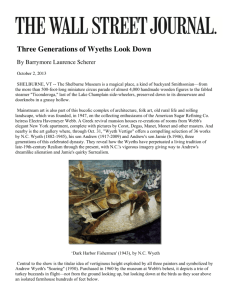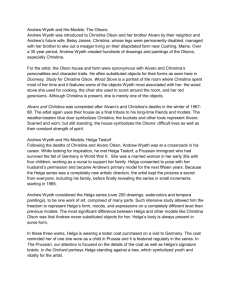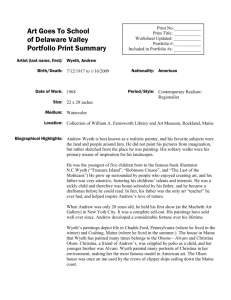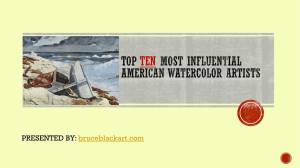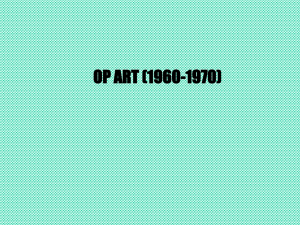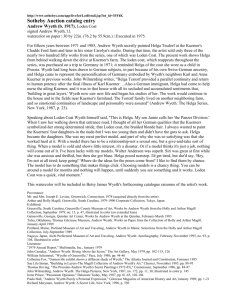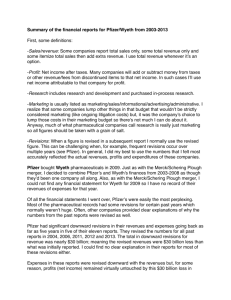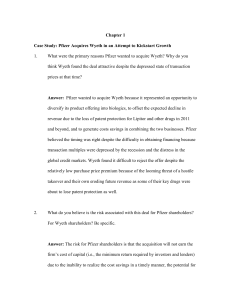Building Blocks - Mark Twain Elementary PTO
advertisement
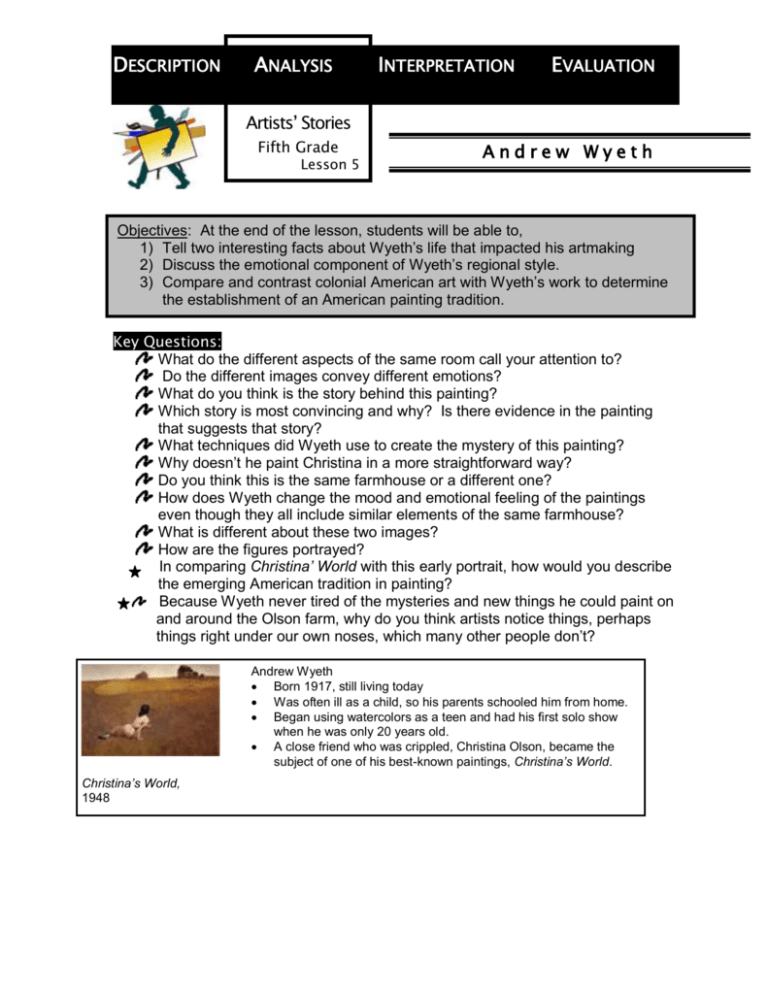
DESCRIPTION ANALYSIS INTERPRETATION EVALUATION Artists’ Stories Fifth Grade Lesson 5 Andrew Wyeth Objectives: At the end of the lesson, students will be able to, 1) Tell two interesting facts about Wyeth’s life that impacted his artmaking 2) Discuss the emotional component of Wyeth’s regional style. 3) Compare and contrast colonial American art with Wyeth’s work to determine the establishment of an American painting tradition. Key Questions: What do the different aspects of the same room call your attention to? Do the different images convey different emotions? What do you think is the story behind this painting? Which story is most convincing and why? Is there evidence in the painting that suggests that story? What techniques did Wyeth use to create the mystery of this painting? Why doesn’t he paint Christina in a more straightforward way? Do you think this is the same farmhouse or a different one? How does Wyeth change the mood and emotional feeling of the paintings even though they all include similar elements of the same farmhouse? What is different about these two images? How are the figures portrayed? In comparing Christina’ World with this early portrait, how would you describe the emerging American tradition in painting? Because Wyeth never tired of the mysteries and new things he could paint on and around the Olson farm, why do you think artists notice things, perhaps things right under our own noses, which many other people don’t? Andrew Wyeth Born 1917, still living today Was often ill as a child, so his parents schooled him from home. Began using watercolors as a teen and had his first solo show when he was only 20 years old. A close friend who was crippled, Christina Olson, became the subject of one of his best-known paintings, Christina’s World. Christina’s World, 1948 Lesson Cycle Focus: (5 min.) Either have a student volunteer take 5 polaroids of different areas of the classroom or use a digital camera to take 5 different angles of the same classroom and include those images in the powerpoint. Ask students to look at how different the images are. What do the different aspects of the same room call your attention to? Do the different images convey different emotions? Tell students that today they will be looking at another Regionalist artist (have students tell you about Grant Wood’s Regionalism from the previous lesson), but this artist did not paint his own backyard because of a rejection of European trends in art, but instead he chose local subject matter because he found it so compelling and interesting. He has said “I have to find a reason for painting a thing,” and so there is a story behind every one of his paintings. He created painted mysteries in his own backyard. Guide the Group: (15 min.) Have students look at Christina’s World, Wyeth’s most famous painting. Ask for a few volunteers to make up the story that they think goes with this painting: What do you think is the story behind this painting? (If a precocious 5th grader knows who Christina is and relates her story, just accept that as one of the versions and solicit 2 or 3 more). After you hear 2 or 3, ask students: Which story is most convincing and why? Is there evidence in the painting that suggests that story? Tell students about Christina Olson, Wyeth’s neighbor, and the fact that his art studio was in her family’s farmhouse. Christina was partially crippled by paralysis when she was a baby. She got around by crawling or moving in a chair. Wyeth found her a remarkable woman and used her as the subject of numerous paintings. This picture grew out of an incident when Wyeth saw Christina, out to pick berries, looking back across a field towards her house. This area was the entire world to Christina, as she had great trouble getting around because of her crippled state. What techniques did Wyeth use to create the mystery of this painting? Why doesn’t he paint Christina in a more straightforward way? Independent Practice: (15 min) Show students a series of paintings that all have aspects of the farmhouse in them, but all are a little different. Ask students: Do you think this is the same farmhouse or a different one? How does Wyeth change the mood and emotional feeling of the paintings even though they all include similar elements of the same farmhouse? Fifth Grade Lesson 5, page 2 Think back to the images of the classroom at the beginning of the lesson. Have students use a picture frame to frame an aspect of the classroom that they think would tell an interesting story. Discuss with students what angle of the classroom they have chosen to frame to tell their interesting story. Art Review: (10 min.) Show students Christina’s World and Copley’s Portrait of Paul Revere. Ask students: What is different about these two images? How are the figures portrayed? Remember the colonial portrait artists were imitating the European portraiture tradition because America was a young country with no artistic tradition of its own. In comparing Christina’ World with this early portrait, how would you describe the emerging American tradition in painting? (sample answers may include: the tradition is more personal and emotional; there are more open interpretations possible of Wyeth’s works.) Closure: (5 min.) Ask the EVALUATION QUESTION: Because Wyeth never tired of the mysteries and new things he could paint on and around the Olson farm, why do you think artists notice things, perhaps things right under our own noses, which many other people don’t? Student responses could include that artists pay more attention to detail, or that they are interested in seeing the world in ways that other people don’t, so they make a point of depicting the world differently. Fifth Grade Lesson 5, page 3 Lesson Resources Andrew Wyeth Time Line July 12, 1917 Andrew Wyeth’s birthday. 1937 Held his first one-man show of watercolors painted around the family's summer home at Port Clyde, Maine. 1939 Wyeth marries Betsey James when he is 22 years old. 1944 Paints Turkey Pond. 1951 His first solo museum exhibition was presented in 1951 at the Farnsworth Art Museum. 1979 Paints Braids. 1948 Paints Christina’s World. 1965 Paints In the Studio. Present Andrew Wyeth is still alive today. Fifth Grade Lesson 5, page 4 Andrew Wyeth was born July 12, 1917 in Chadds Ford, Pennsylvania. He was the youngest of five children. Andrew was a sickly child and so his mother and father made the decision to pull him out of school after he contracted whooping cough. His parents home-schooled him in every subject including art education. Andrew had a vivid memory and fantastic imagination that led to a great fascination for art. His father recognized an obvious raw talent that had to be nurtured. While his father was teaching him the basics of traditional academic drawing, Andrew began painting watercolor studies of the rocky coast and the sea in Port Clyde Maine. He worked primarily in watercolors and egg tempera and often used shades of brown and gray. He held his first one-man show of watercolors painted around the family's summer home at Port Clyde, Maine in 1937. It was a great success that would lead to plenty more. He married at the age of twenty-two to a local girl named Betsey James and had two boys, Nicholas who became an art dealer, and James who became the third generation artist in his family. Betsey introduced Andrew to her longtime friend, Christina Olson, who was crippled. Andrew painted her outside her home in one of his best-known paintings, Christina’s World in 1948. Christina remained friends with Andrew and Betsey until her death in 1968. He was featured on the cover of American Artist as well as many other famous magazines such as the Saturday Evening Post that displayed his painting "The Hunter." His first solo museum exhibition was presented in 1951 at the Farnsworth Art Museum. Since then he has seen many more successes and is considered one of the most "collectable" living artist's of our time. "With watercolor, you can pick up the atmosphere, the temperature, the sound of snow shifting through the trees or over the ice of a small pond or against a windowpane. Watercolor perfectly expresses the free side of my nature." - Andrew Wyeth Images Christina’s World (1948) http://www.artchive.com/ftp_site_reg.htm The Master Bedroom, (??) http://www.awyethgallery.com/andrew/master.html Braids (1979) http://www.norton.org/exhibit/archive/wyeth/wyeth.htm Up in the Studio (1965) http://cgfa.sunsite.dk/w/p-wyeth5.htm Turkey Pond (1944) Biography http://www.andrew-wyeth-prints.com/biography.html http://farnsworthmuseum.org/wyeth/andrew.html Fifth Grade Lesson 5, page 5
